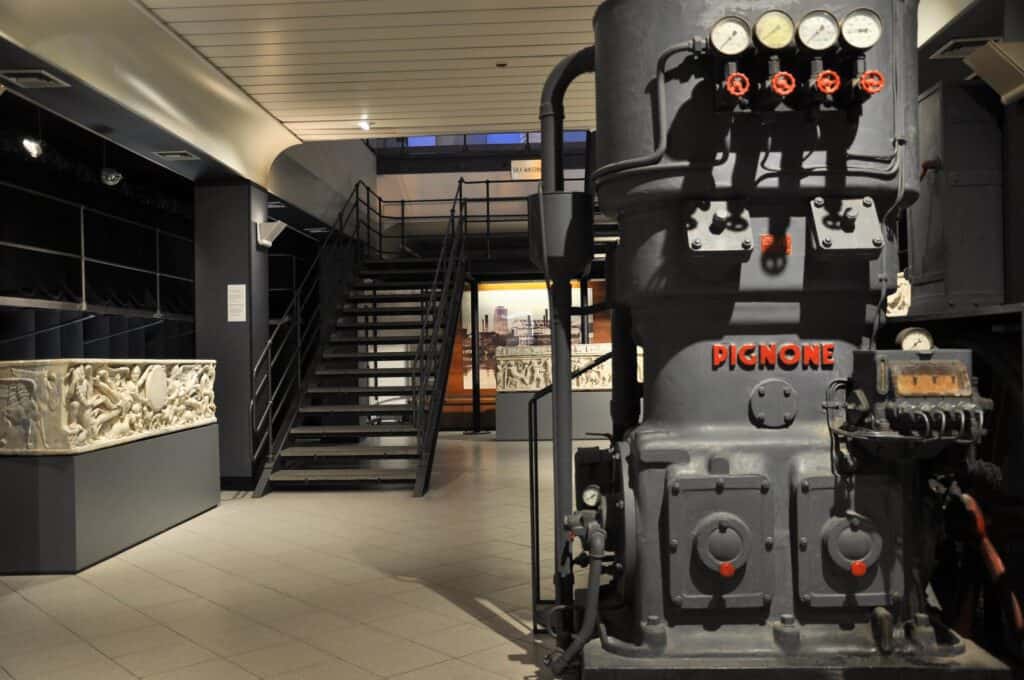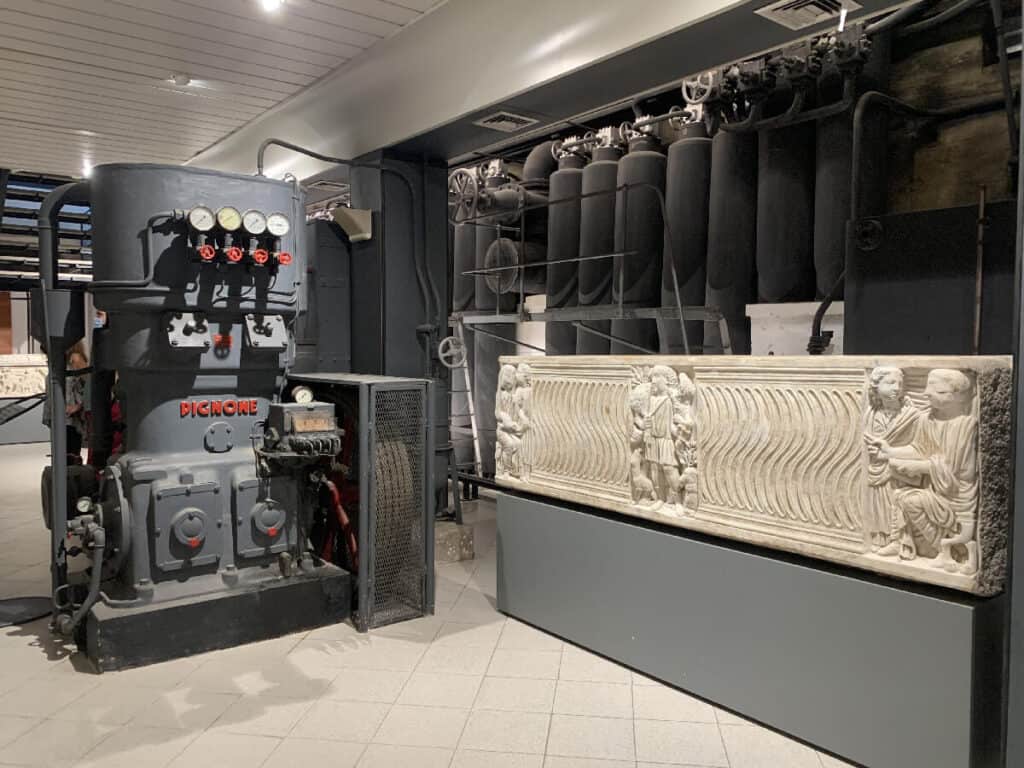Ancient artworks on display at Rome’s industrial space
At Centrale Montemartini, classical art and industrial archaeology mingle perfectly at Rome’s first electrical plant. Located in the industrial area of Ostiense, Centrale Montemartini stands as a perfect example of upcycling.
Centrale Montemartini Museum presents marble statues from the Capitoline Collection set against the backdrop of preserved turbines, diesel engines and steam boilers to create one of the most thought-provoking museum spaces Rome has to offer.
In 1997, the vast halls of the Centrale Montemartini, filled with gigantic surviving machinery, were considered as an alternative to the exhibition of works while the Capitoline Museums were being renovated. It was a suitable solution for experiencing new museographic solutions.
Two diametrically opposed worlds, archeology and industrial, were brought together for the first time through a courageous set-up. For the exhibition later entitled Machines and The Gods, the space was organized in such a way that the pre-existing objects and what they wanted to show remained intact and did not alter their nature. The machinery was restored and the space adapted for its new intended use.
In 2001, after the success of the exhibition that attracted the interest of the public and professionals by its daring combination, the Centrale Montemartini halls were consolidated as a new artistic space. It passed from a temporary experiment to a permanent museum. Becoming a branch of the Capitoline Museums, the new exhibition spot has been since then enriched with new spaces and archaeological finds.

The visit to the museum starts in the corridors of the large Atrium, on the ground floor. High compressed air cylinders are lined up on both sides —used to start the diesel engines of the engine room above— set the tone for how the space integrates its artistic present and industrial past.

The papal train that was built for Pope Pius IX in 1858 can be found in one of the two boiler rooms on the ground floor. The other boiler room now tells the story of the late 19th-century urban transformation and the 20th-century fascist period, using informational panels. Between each of them, is a piece displaying Roman Sarcophagi and engraved artifacts that were meant to give positive portrayals of the afterlife. It is safe to say that the resurrection theme on this floor speaks to both the art and the old plant.

The history of the Montemartini power plant is narrated through the walls with didactic boards accompanied by photos and old plants, from its construction to its final transformation into a museum. The museum’s exhibitions itinerary seeks to create a narrative that shows the most significant moments in the history of the monumental development of the city of Rome, since its earliest phases. It shows the important urban transformations of the Italian capital through the evolution of archeology works and excavations carried out over the years.

The Sala Colonne (Column Room) has this name because of the numerous reinforced concrete pillars erected to support the three boilers on the upper floor. This session brings together extraordinary testimonies regarding the origins of the city of Rome, its people and its customs —in addition to a collection of precious objects brought to Rome from Greece, demonstrating Hellenic society influence. Through funerary objects and decorative fragments of aristocratic tombs, visitors can observe what life was like in ancient Rome and its relationship with other peoples. In a long gallery, there is a series of portraits dating from the 1st century BC, with the reproduction of representatives of different social classes of Roman society. Among the portraits of famous people are those of Caesar and Augustus.


On the second floor, visitors reach the Sala Macchine (Engine Room) and come across two gigantic and impressive diesel engines. Amidst such majestic industrial grandeur, there is a series of delicate sculptures based on Ancient Greece, through faithful copies of the most famous and original Greek sculptures. Alongside, there is the exhibition of reformulated works according to the taste of the Romans and the cultural climate of the time. While it may seem unlikely for such a museum to obtain a minimalist style, Centrale Montemartini puts effort into leaving the walls empty and the rooms open, allowing two worlds to flatter one another. While the large engines give the space its grandeur, the art adds warmth and color to the cold tones, so that with each turn you can appreciate both elements of the museum.
The reconstruction of the pediment of the Temple di Apollo Sosiano occupies a prominent place in this room, calling the attention of any visitor who is strolling through the museum. Narrating the battle between Greeks and Amazons, numerous marble sculptures of famous characters, such as Hercules and Athena, are displayed throughout the room’s interior decoration.
INSPIRATION
Best Museums in Rome

One of the most impressive and breathtaking areas of the museum is dedicated to the artifacts found in Largo Argentina, a famous archaeological site in the center of Rome. Composed in the past by four temples, fragments of a colossal female sculpture were found in one of the ruins. The cult statue of the temple itself was about 8m high and visitors can get a sense of its size and artistic perfection from the exposure of its right arm, head and foot in the museum.
Next in the museum, visitors arrive in the Sala Caldaie (Boiler Room) where a large steam boiler stands. Being the only survivor of the three originally installed, it rises from floor to ceiling in an interwoven complex of pipes, bricks and metal walkways. This huge room displays the elements of sculptural decoration, statues and busts, relief plaques and portraits found in gardens and private residences of emperors and other important personalities in the history of Rome. With several works that narrate battle victories and Greek originals, this space offers visitors an experience of immersing themselves in the private and luxurious life of the rich Romans.

Aside from the fixed art, the museum also hosts a number of different exhibitions throughout the year. Until March 2023, the exhibition “The Colors of the Romans. Romani. Mosaics From The Capitoline Collections” will be presenting a wide selection of mosaics, masterpieces of the Capitoline collections which are not well known by the general public. By illustrating the discovery of Rome through the colorful texture of art pieces, this exhibition brings together chapters of the history of the Eternal City.
Immerse yourself in two worlds at Centrale Montemartini, a former electrical power plan in Rome that now houses sculptures from the Capitoline collection. Book our Private Tour.
Address
Via Ostiense, 106 (Ostiense)
Opening time
Tuesday – Sunday 9am – 7pm






I love this place! Watch my video on it: http://www.fabiomarzocca.com/blog/2015/03/22/gods-heroes-and-techne/